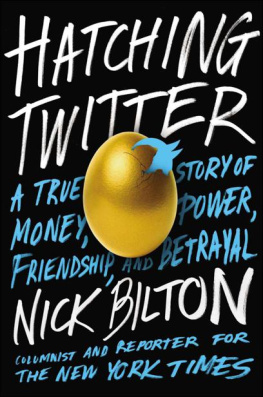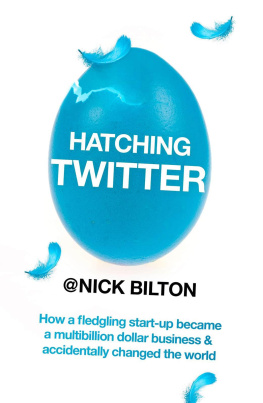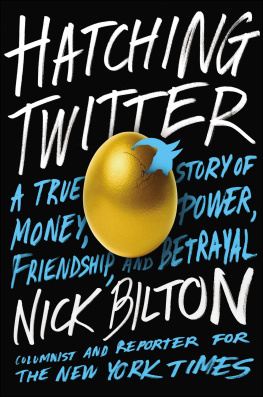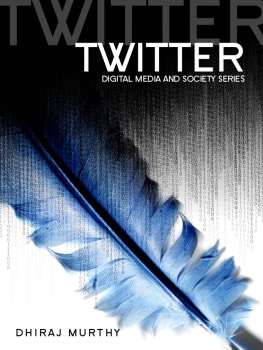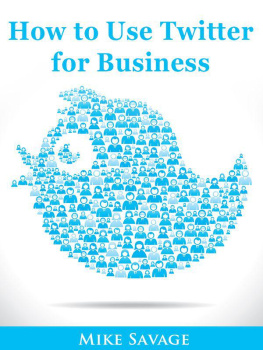Nick Bilton - Hatching Twitter: A True Story of Money, Power, Friendship, and Betrayal
Here you can read online Nick Bilton - Hatching Twitter: A True Story of Money, Power, Friendship, and Betrayal full text of the book (entire story) in english for free. Download pdf and epub, get meaning, cover and reviews about this ebook. year: 2013, publisher: Portfolio, genre: Detective and thriller. Description of the work, (preface) as well as reviews are available. Best literature library LitArk.com created for fans of good reading and offers a wide selection of genres:
Romance novel
Science fiction
Adventure
Detective
Science
History
Home and family
Prose
Art
Politics
Computer
Non-fiction
Religion
Business
Children
Humor
Choose a favorite category and find really read worthwhile books. Enjoy immersion in the world of imagination, feel the emotions of the characters or learn something new for yourself, make an fascinating discovery.
- Book:Hatching Twitter: A True Story of Money, Power, Friendship, and Betrayal
- Author:
- Publisher:Portfolio
- Genre:
- Year:2013
- Rating:3 / 5
- Favourites:Add to favourites
- Your mark:
Hatching Twitter: A True Story of Money, Power, Friendship, and Betrayal: summary, description and annotation
We offer to read an annotation, description, summary or preface (depends on what the author of the book "Hatching Twitter: A True Story of Money, Power, Friendship, and Betrayal" wrote himself). If you haven't found the necessary information about the book — write in the comments, we will try to find it.
But I invented Twitter, Jack said.
No, you didnt invent Twitter, Ev replied. I didnt invent Twitter either. Neither did Biz. People dont invent things on the Internet. They simply expand on an idea that already exists.
In 2005, Odeo was a struggling podcasting start-up founded by free-range hacker Noah Glass and staffed by a motley crew of anarchists. Less than two years later, its days were numbered and half the staff had been let go. But out of Odeos ashes, the remaining employees worked on a little side venture . . . that by 2013 had become an $11.5 billion business.
That much is widely known. But the full story of Twitters hatching has never been told before. Its a drama of betrayed friendships and high-stakes power struggles, as the founders went from everyday engineers to wealthy celebrities featured on magazine covers, The Oprah Winfrey Show, The Daily Show, and Times list of the worlds most influential people.
New York Times columnist and reporter Nick Bilton takes readers behind the scenes as Twitter grew at exponential speeds. He gets inside the heads of the four hackers out of whom the company tumbled:
Evan Ev Williams, the ambitious farm boy from Clarks, Nebraska, who had already created Blogger and sold it to Google for millions. Quiet and protective, Ev is a shrewd businessman who made tough choices in the interest of his companies, firing cofounders and employees who were once friends.
Jack Dorsey, the tattooed nobody who helped mastermind the original concept of Twitter, became a billionaire tech titan, and convinced the media that he was the next Steve Jobs.
Christopher Biz Stone, the joker and diplomat who played nice with everyone. As drama ensued, he was the only founder who remained on good terms with his friends and to this day has no enduring resentments.
Noah Glass, the shy but energetic geek who invested his whole life in Twitter, only to be kicked out and expunged from the companys official history.
As Twitter grew, the four founders fought bitterly for money, influence, publicity, and control over a company that grows larger and more powerful by the day. Ultimately they all lost their grip on it. Today, none of them is the CEO. Dick Costolo, a fifty-year-old former comedian, runs the company.
By 2013 Twitter boasted close to 300 million active users around the world. In barely six years, the service has become a tool for fighting political oppression in the Middle East, a marketing musthave for business, and the worlds living room during live TV events. Today, notables such as the pope, Oprah Winfrey, and the president of the United States are regular Twitter users. A seventeen-year-old with a mobile phone can now reach a larger audience than an entire crew at CNN.
Biltons unprecedented access and exhaustive investigating reportingdrawing on hundreds of sources, documents, and internal e-mailshave enabled him to write an intimate portrait of four friends who accidentally changed the world, and what they all learned along the way.
Nick Bilton: author's other books
Who wrote Hatching Twitter: A True Story of Money, Power, Friendship, and Betrayal? Find out the surname, the name of the author of the book and a list of all author's works by series.

